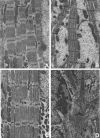Taking pressure off the heart: the ins and outs of atrophic remodelling
- PMID: 21354996
- PMCID: PMC3115281
- DOI: 10.1093/cvr/cvr060
Taking pressure off the heart: the ins and outs of atrophic remodelling
Abstract
Our work on atrophic remodelling of the heart has led us to appreciate the simple principles in biology: (i) the dynamic nature of intracellular protein turnover, (ii) the return to the foetal gene programme when the heart remodels, and (iii) the adaptive changes of cardiac metabolism. Although the molecular mechanisms of cardiac hypertrophy are many, much less is known regarding the molecular mechanisms of cardiac atrophy. We state the case that knowing more about mechanisms of atrophic remodelling may provide insights into cellular consequences of metabolic and haemodynamic unloading of the stressed heart. Overall we strive to find an answer to the question: 'What makes the failing heart shrink and become stronger?' We speculate that signals arising from intermediary metabolism of energy-providing substrates are likely candidates.
Figures



Similar articles
-
Myocardial energetics in cardiac hypertrophy.Clin Exp Pharmacol Physiol. 2002 Apr;29(4):351-9. doi: 10.1046/j.1440-1681.2002.03657.x. Clin Exp Pharmacol Physiol. 2002. PMID: 11985549 Review.
-
Mechanisms of physiological and pathological cardiac hypertrophy.Nat Rev Cardiol. 2018 Jul;15(7):387-407. doi: 10.1038/s41569-018-0007-y. Nat Rev Cardiol. 2018. PMID: 29674714 Review.
-
Insights into metabolic remodeling of the hypertrophic and failing myocardium.Circ Heart Fail. 2014 Nov;7(6):874-6. doi: 10.1161/CIRCHEARTFAILURE.114.001803. Circ Heart Fail. 2014. PMID: 25415956 Free PMC article. No abstract available.
-
Subcellular remodelling may induce cardiac dysfunction in congestive heart failure.Cardiovasc Res. 2009 Feb 15;81(3):429-38. doi: 10.1093/cvr/cvn281. Epub 2008 Oct 13. Cardiovasc Res. 2009. PMID: 18852252 Review.
-
Metabolic Coordination of Physiological and Pathological Cardiac Remodeling.Circ Res. 2018 Jun 22;123(1):107-128. doi: 10.1161/CIRCRESAHA.118.312017. Circ Res. 2018. PMID: 29929976 Free PMC article. Review.
Cited by
-
Lower Cardiorespiratory Fitness Is Associated With Right Ventricular Geometry and Function - The Sedentary's Heart: SHIP.J Am Heart Assoc. 2021 Nov 16;10(22):e021116. doi: 10.1161/JAHA.120.021116. Epub 2021 Nov 6. J Am Heart Assoc. 2021. PMID: 34743534 Free PMC article.
-
Thbs1 induces lethal cardiac atrophy through PERK-ATF4 regulated autophagy.Nat Commun. 2021 Jun 24;12(1):3928. doi: 10.1038/s41467-021-24215-4. Nat Commun. 2021. PMID: 34168130 Free PMC article.
-
Enhanced Ca²+ influx through cardiac L-type Ca²+ channels maintains the systolic Ca²+ transient in early cardiac atrophy induced by mechanical unloading.Pflugers Arch. 2013 Dec;465(12):1763-73. doi: 10.1007/s00424-013-1316-y. Epub 2013 Jul 11. Pflugers Arch. 2013. PMID: 23842739 Free PMC article.
-
Susceptibility of female rats to cardiac arrhythmias following refeeding after severe food restriction.Biol Sex Differ. 2022 Mar 15;13(1):11. doi: 10.1186/s13293-022-00419-1. Biol Sex Differ. 2022. PMID: 35292078 Free PMC article.
-
Short-Chain Fatty Acids in the Metabolism of Heart Failure - Rethinking the Fat Stigma.Front Cardiovasc Med. 2022 Jul 11;9:915102. doi: 10.3389/fcvm.2022.915102. eCollection 2022. Front Cardiovasc Med. 2022. PMID: 35898266 Free PMC article. Review.
References
-
- Castle WB. Intellectual curiosity and the physician's responsibilities. Pharos. 1959;22:24–30.
-
- Depre C, Shipley GL, Chen W, Han Q, Doenst T, Moore M, et al. Unloaded heart in vivo replicates fetal gene expression of cardiac hypertrophy. Nat Med. 1998;4:1269–1275. - PubMed
-
- Chien KR. Regenerative medicine and human models of human disease. Nature. 2008;453:302–305. - PubMed
-
- Herrmann J, Ciechanover A, Lerman LO, Lerman A. The ubiquitin-proteasome system in cardiovascular diseases-a hypothesis extended. Cardiovasc Res. 2004;61:11–21. - PubMed

